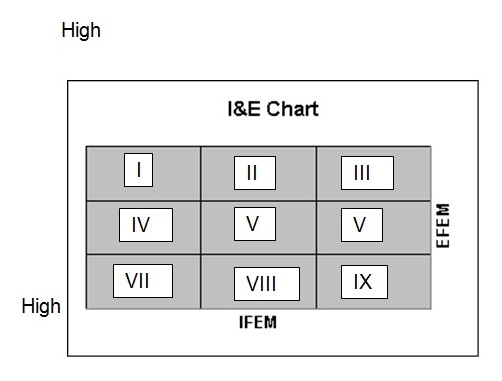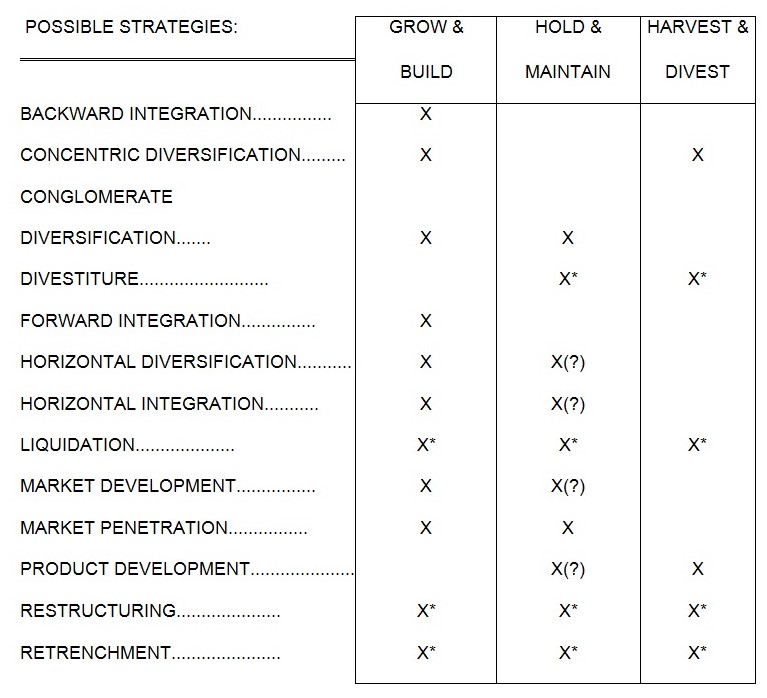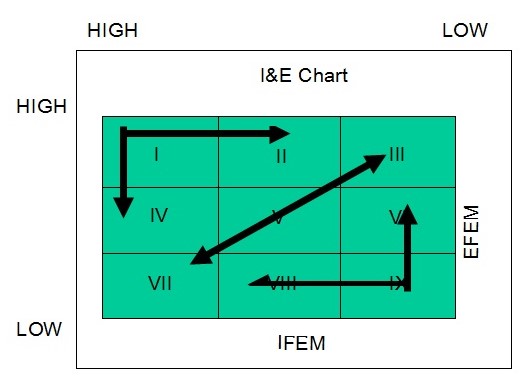Executive Summary in Memo Format
MEMORANDUM_______________________________
TO:__________________________________________
FROM:_______________________________________
DATE:________________________________________
RE: (Internal and External Matrix Analysis: Tracking Down the History and Success of On the Vine Marketplace)
The OTV Company has been in business for years. The organization is aiming at expanding worldwide, yet it needs to get its priorities in line before entering the global market.
The IFEM score of the company amounts to 40. This means that entrepreneurship has matured into a profitable organization. Staff satisfaction, financial stability and high-quality standards are the key strengths that the profitability of the company hinges on.
The EFEM score makes 26, which leaves much to be desired. Nevertheless, the company has several essential EFEM factors, such as the company’s location, its financial approach and its target demographics.
It is suggested that OTV should focus on its technological and R&D departments, therefore, enhancing its information management and providing new customers with the best services possible. The reinforcement of the information management process will also result in an improved data transfer between the company members, thus, galvanizing the production process.
Though it might seem that the OTV Company has reached its prime, there is still enough room for development. Entering the global market presupposes fighting new challenges. Therefore, a major update of the company’s processes is required.
Introduction and Overview
Started as a typical small business by Abel Schultze and Scott Edwards, the On the Vine (OTV) organization has grown into a major corporation in the 21st century. Owing to the organizational values promoted by the founders and inculcated in its employees since the company was started, OTV has been enjoying quite impressive success in the target market. The organization sells food and beverages and is located in Exeter Common’s Shopping Center, in Exeter, NH (School of Business 2). The current stage of the organization’s life cycle can be identified as maturity, as the company has obviously slackened down its pace of development, yet has not passed its prime yet.

Mission, Goals and Current Strategies
Because of the necessity to expand, the organization will have to consider the means of integrating into the global market and at the same time retaining its corporate values, which make the company so efficient at present. Furthermore, the global economy realm will require the introduction of value-added products for targeting a wider range of customers, particularly, the male demographics (School of Business 3). Moreover, it is essential that the OTV should retain its originality by keeping its current marketing approach intact. As a result, the OTV is expected to advance in the global competition process and land at the top of the current list of the most successful food companies.
Internal Analysis
The IFEM score of the company makes 40, which is quite impressive for OTV, as it shows that the organization has reached great success. Armed with an innovative strategy for attracting its target audience and having identified the latter in a rather precise manner, the OTV Company has been delivering a rather impressive score in the local market of Maine. The company is clearly capable of delivering a rather impressive performance within the global setting due to the rigid set of principles that it is guided by. However, the insufficient pace of changes within the organization, as well as a complete absence of the R&D department, may jeopardize its success in the global setting. It was weighted at 36 because most of the latest changes have had a major effect on the organization and its performance.
Management
- Support for each staff member is essential for enhancing the motivation of the staff and, therefore, increasing their productivity (major strength). It was weighted at 4 because it is the key to the company’s operations;
- Promotion of staff satisfaction has a similar effect to that of one of the employees’ support and is most likely to trigger a major increase in the loyalty of the staff (major strength). It was weighted at 4 because it has a major effect on the company’s operations;
- Incorporation of rigid values will help the organization to control the performance of the staff and imbue the idea of personal and professional responsibility into them (minor strength). It was weighted at 3, because it has a moderate sense of urgency.
Finance
- Financial stability creates an atmosphere of security and allows the organization to draw long-term plans (major strength). It was weighted at 4, because it affects the company’s annual profit greatly;
- A reasonable pricing strategy sets the expectations among the target audience for the company to meet (minor strength). It was weighted at 2, because its effects on new types of customers have not been tested yet;
- Proper resources allocation minimizes the expenses made by the company (major strength). It was weighted at 4, because it helps maintain corporate financial stability;
- Current ratio: Total Current Assets (Balance sheet) divided by Total Current Liabilities: $85,000/($100,000 + $75,000) = 0.486
- Asset Turnover Ratio: Net Sales (Income Statement) divided by Total Assets (Balance Sheet): $180,000/$250,000 = 0.72
- Profitability Ratio: PV (future cash flows)/Initial Investment: $500,000/$250,000 = 2
Marketing and Service
- Unique strategy for promoting the organization in the global market helps the customers distinguish OTV among the rest of food companies (minor strength). It was weighted at 3, because it affects the company’s performance considerably;
- Product differentiation helps identify the key audience in a more accurate manner (targeting at three key markets, i.e., deli, bakery, meat) (minor strength). It was weighted at 1, because a new product brand is yet to be defined;
- Consumer education contributes to enhancement of customer loyalty (major strength, low sense of urgency). It was weighted at 1, because it still exists only as a concept.
Production and Operations
- High quality standards define the company’s reputation as very high (major strength). It was weighted at 4, because it allows for defining the company’s place in the new market;
- Emphasis on logistics allows for locating the least expensive ways of delivering the products and the raw materials (major strength). It was weighted at 4, because it helps improve service quality.
Human Resource Management
- Staff satisfaction as a top priority triggers a sharp rise in employee motivation and, therefore, rises performance rates (major strength). It was weighted at 4, because it creates the basis for productive opertaions;
- Investments in the current staff promote loyalty and help create a team of highly qualified experts (major strength). It was weighted at 4, because it promotes company’s evolution.
Research and Development
- No R&D at present may soon result in misconceptions concerning customers’ demands and, therefore, a major failure in the future (major weakness). It was weighted at 1, because it is the weakest link in the company’s design.
Other Relevant Internal Factors
- Incorporation of the latest technological advances defines the success of the company in the realm of the IT environment (major strength). It was weighted at 4, because technology is essential for information management;
- Register and card systems improvements creates the premises for a more efficient process of selling the final product (minor strength). It was weighted at 2, because the concept is still in development.
External Analysis
The external score of the organization makes 26, which means that the organization needs to work on a range of issues in order to meet the existing requirements. An external analysis of the company’s assets has shown that the OTV has a rather big potential for integrating into the realm of global economy; however, the overview of the company’s chances for integrating in the global economy have shown that the OTV is unlikely to succeed in the global market without a solid R&D strategy for analyzing the customers’ demands and designing the products and services that will meet the needs of the target audience. Indeed, while in the home market, the company could feel relatively secure in terms of its status and popularity due to the understanding of the needs of the local residents, the integration into the global market is most likely to lead the company into a conundrum of new demands that OTV may fail to meet. It was weighted at 36, because some of the recent advances can be defined as minor.
Economic
- Low competition rates are bound to enhance the company’s benefits (major opportunity, moderate sense of urgency);
- Unpredictability of alterations that the company may undergo when transferring into a different market may jeopardize the company’s success (minor threat, moderate sense of urgency)
Social and Cultural
Poor understanding of the customers and their demands may lead to a significant drop in annual revenues (major threat). It was weighted at 4, because it defines the company’s fate.
Demographic
The need to produce more food in order to meet the needs of a wider audience will require that the company should employ a different technology and enhance its transportation strategy (major opportunity). It was weighted at 4, because it helps locate the advertisement strategy.
Other Relevant External Factors
- The creation of a website will demand that the services of experts in design and computer technology should be used. Therefore, additional expenditures will be made (minor threat). It was weighted at 1, because it is one of the smallest concerns;
- The location of the company can be viewed as a major advantage that should be used for the OTV’s benefit (major opportunity). It was weighted at 4, because it is a gateway for the company’s success in the new market.
I&E Matrix Analysis
The I&E Matrix is traditionally defined as “another strategic tool used to analyze working conditions and strategic position of a business” (Bhandari 242). In other words, the specified concept represents a framework for evaluating the potential of an organization in general and its chances for becoming a part of the global market in particular.
The I&E Matrix provided below displays the chances that the OTV company has in integrating into the global market and succeeding in the specified realm as a one-of-a-kind food producing organization. There is no need to stress that the OTV organization has proven to be equipped with a unique approach, which may work outstandingly well in the global environment. After all, a range of powerful enterprises that have reached the pinnacle of economic and financial development have been known as the companies that are concerned with the satisfaction of their staff as much as with that of their clients. Therefore, with a set of strong and positive principles to rely on, the OTV Company is likely to succeed in the global environment. However, the lack of consistency in its marketing approach, as well as a complete absence of R&D, raises a few questions.
As far as the strategies that can be recommended for the company are concerned, based on the information provided in the matrix, it will be reasonable to assume that the organization will benefit from reconsidering its priorities and focusing on the design of its R&D strategy as a major tool for entering the global economy. It should be born in mind, though, that the redesign of the company’s strategies and the development of a new department will require major financial support. Herein the need to relocate the current financial strategy lies; specifically, the company will have to invest in the R&D instead of paying as much attention to the employees’ motivation as it used to. Particularly, financial incentives for the staff may be reduced, which the employees are most likely to disapprove of. At this point, OTV’s focus on employees’ loyalty factors in; as long as the staff feels respected and appreciated, a minor drop in incentives will not hinder their motivation and engagement from remaining at the same level. Therefore, putting a stronger emphasis on the R&D design and the further integration into the global economy is imperative for OTV at present.
The Internal and External Factor Matrix (I/E)



Recommended Strategic Vision and Supporting Strategies
Vision
Suggesting that the company’s vision should revolve around the same concept of employee satisfaction seems quite legitimate, as the specified strategy was the factor that contributed to the company’s success in the local market. However, seeing that OTV is expanding into the global environment, it will be more adequate for the vision to encompass all the stakeholders involved, including the customers, the staff, the future partners, etc. Therefore, the vision of the organization should be geared towards facilitating the satisfaction to all its stakeholders and providing the products of the finest quality as the proof for caring for the customers’ health and encouraging a healthy lifestyle.
Grand Strategies and Supporting Strategies
The tools for creating an R&D department in an organization are quite numerous. According to the Generic Grand Strategy Matrix, the company has quite a range of assets to be integrated into the process of creating the R&D department. Seeing that the latter is what the organization must put most of its stakes on, it will be rather adequate to suggest that certain costs of the company should be cut to a reasonable degree so that the remaining money could be spent on the design and growth of the R&D department.
As far as the R&D strategy is concerned, it can be suggested that the emphasis should be made on enhancing the market analysis system. Indeed, seeing that these are the processes, both within the organization and in the target market, that the OTV Company is concerned with, enhancing the analysis of the new audiences, their demands, the standards to be met, etc., seems a very legitimate step to make.
Strategic Intent
A closer focus on the new market and its elements, particularly, the audience and its demands, is the strategic intent of the organization.
- Functional Areas Considerations (SAMPLE Follows)
- Functional area: research and development
SWOT Factors:
- S – Strong corporate ethics
- S – Focus on staff satisfaction
- W – Absence of R&D
- W – Lack of understanding of new customers’ demands
- O – New market exploration
- O – Promoting consumer education
- O – Becoming a leader in the target market niche
- T – Failure due to imperfections in the R&D strategy
Action Plan/Considerations
A thorough investigation of the food target market must be carried out so that the basis for the design of an R&D strategy should be provided. Afterwards, a proper R&D strategy should be designed based on the findings of the market research. It is suggested that the market analysis will return the results manifesting the need to appeal to a rather diverse audience; as a result, the necessity to reconsider the marketing approach, particularly, the symbols that the OTV Company use in order to attract its clients, should be reconsidered. Instead of the ones that are currently used, the incorporation of more general images and symbols may be suggested after the market research results are delivered.
Metric/Measurements
The success of the actions to be undertaken by the firm will be measured by comparing the sales rates with the expected ones. The measurement outcomes will be provided in percentage. As soon as the new marketing strategy is adopted and the products are promoted to the target customers, a new measurement will be carried out so that the effects of the change could be identified by comparing the specified results with the outcomes of the previous measurement. It is suggested that a rapid growth in the company’s revenues will follow the creation of the R&D Department and the alterations in the marketing approach.
Works Cited
Bhandari, Arabinda. Strategic Management: A Conceptual Framework. New Delhi, IN: Tata McGraw Hill Education, 2013. Print.
School of Business. Case Study: On the Vine. Boston, MA: Organizational Leadership Department, School of Business, 2014. Print.
